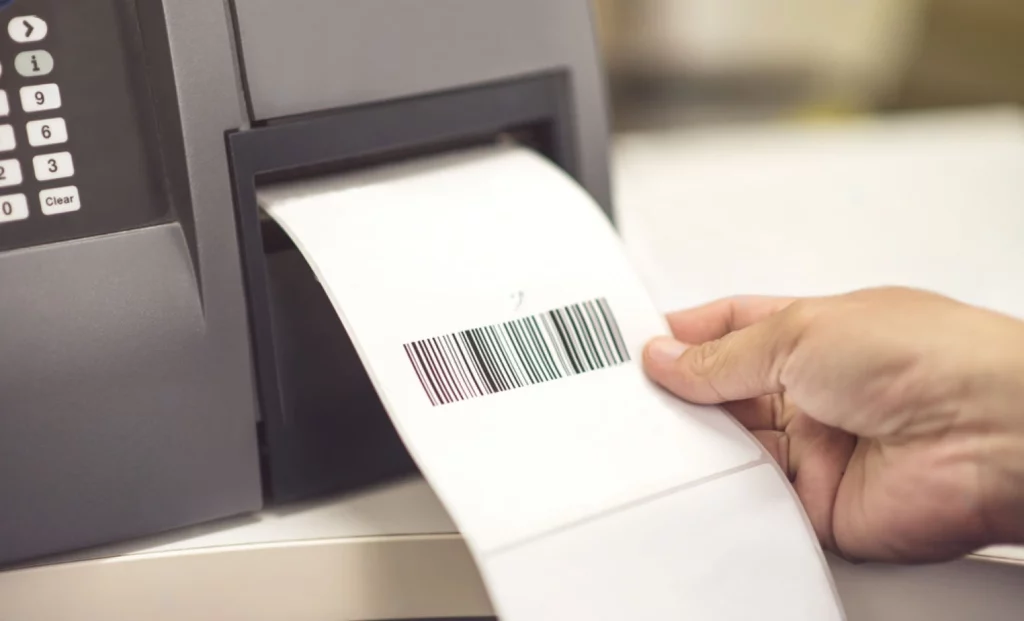As a business owner, choosing the correct printing method becomes crucial for your business’s success. Direct thermal printing and thermal transfer printing are two widely used printing methods that provide cost-effective and reliable printing solutions for businesses of any size.
Direct thermal printing uses heat-sensitive label stock to create an image without needing ink or toner. It’s ideal for short-term labeling but can be made more durable with a protective topcoat.
On the Other hand, thermal transfer printing is more durable and versatile, making it ideal for long-term labeling and printing on a broader range of materials. Consider your business needs and materials before deciding on a printing method.
Direct Thermal Printing
Direct thermal printing is a simple and efficient method that requires no additional ink or toner. Instead, it uses a heat-sensitive label stock that reacts to heat by producing an image.
This process is achieved by heating and applying a thermal ribbon to the label stock. Direct thermal printing is ideal for applications that require short-term labelings, such as shipping labels, retail price tags, and receipts.
However, the images produced through direct thermal printing can fade over time and are less durable than those made with thermal transfer printing.
When it comes to printers for direct thermal printing, there are several top brands to choose from. Here are some of the best direct thermal printers on the market:
- Zebra Technologies: Zebra Technologies is a leading manufacturer of direct thermal printers, offering a wide range of models to suit different printing needs. Their printers are known for their durability, reliability, and ease of use, making them a popular choice among businesses that need to print high volumes of labels.
- Datamax-O’Neil: Datamax-O’Neil is another popular brand of direct thermal printers, offering a range of models that are designed to meet the needs of different industries. Their printers are known for their high-quality printing, fast printing speeds, and durable construction.
- Brother: Brother is a well-known brand in the printing industry, and they also offer a range of direct thermal printers. Their printers are known for their affordability, ease of use, and reliability, making them a popular choice among small businesses.
Direct Thermal Printing Advantages
Direct thermal printing is a popular printing method used by businesses of all sizes due to its cost-effectiveness and reliability. Here are some of the advantages of direct thermal printing:
- No need for ink or toner: Direct thermal printing uses heat-sensitive paper that darkens when exposed to heat, eliminating the need for ink or toner. This makes direct thermal printing a more cost-effective printing solution.
- Quick and easy: Direct thermal printing is a fast and easy process, as it does not require any additional steps such as changing ink or toner cartridges.
- Low maintenance: Direct thermal printers require minimal maintenance, which makes them a popular choice for businesses looking for a reliable and low-maintenance printing solution.
- Versatile: Direct thermal printing is versatile and can be used for a wide range of applications, including barcodes, shipping labels, and receipts.
Direct Thermal Limitations
- Direct thermal printing can only produce black and white prints, limiting the range of colors that can be used.
- Direct thermal labels have a shorter lifespan than thermal transfer labels as they are more susceptible to fading and smudging.
- Direct thermal labels are also more sensitive to environmental factors such as heat and sunlight, which can further reduce their lifespan.
Thermal Transfer Printing
On the other hand, thermal transfer printing uses a thermal ribbon to transfer an image onto the label stock.
This method is more versatile and durable than direct thermal printing, making it ideal for applications that require long-term labeling or printing on a broader range of materials.
Thermal transfer printing can produce high-quality images with sharp text and fine details, making it suitable for product labels, barcodes, and identification tags.
Additionally, thermal transfer printing is available in various ribbon colors, allowing businesses to create custom labels for branding and marketing purposes. There are several brands that offer reliable and high-performance thermal transfer printers, including:
- Zebra: Zebra is a leading manufacturer of thermal transfer printers, known for their durability and high-speed printing capabilities. Their printers are ideal for industrial and commercial applications, such as inventory management, shipping, and asset tracking.
- Brady: Brady is a trusted name in the label and sign-making industry, offering a wide range of thermal transfer printers and supplies. Their printers are known for their user-friendly interface and high-quality printing capabilities, suitable for various applications.
- TSC: TSC is a global leader in thermal transfer printing solutions, offering a range of affordable and reliable printers for small to medium-sized businesses. Their printers are ideal for printing barcodes, labels, and tags for retail, healthcare, and logistics applications.
- Sato: Sato is a Japanese manufacturer of thermal transfer printers, known for their high-speed printing capabilities and advanced features. Their printers are widely used in the manufacturing, logistics, and healthcare industries, where high-quality and durable labels are essential.
Thermal Transfer Advantages
- Thermal transfer printing produces high-quality, long-lasting labels that resist fading, smudging, and tearing.
- This printing method uses a thermal ribbon to transfer ink to label stock, producing crisp, clear text, images, and barcodes.
- Thermal transfer printing is ideal for printing on various label materials, including paper, polyester, polypropylene, and vinyl.
- Thermal transfer printers are highly versatile, allowing for printing on various label sizes, shapes, and styles.
- Thermal transfer printing is also highly reliable, with minimal maintenance to keep the printer functioning optimally.
- Businesses of any size can benefit from thermal transfer printing, as it is scalable to meet the needs of small, medium, and large-sized businesses.
- The labels produced through thermal transfer printing are highly durable, making them ideal for use in healthcare, manufacturing, and logistics industries, where labels must withstand harsh environments and regular use.
- With thermal transfer printing, businesses can produce high-quality labels in-house, reducing the need for outsourcing printing services and saving time and money.
Thermal Transfer Limitations
- Thermal transfer printing requires the use of a thermal ribbon, which can add to the overall cost of printing.
- The process of changing out the thermal ribbon can be time-consuming and require additional maintenance.
- Thermal transfer printing may not be suitable for printing on extremely small labels or materials that are too thick or too thin.
- Printing with certain colors or on certain materials may require specialized thermal ribbons, which may be more expensive or harder to find.
- Thermal transfer printers may require more space and be less portable than direct thermal printers.
Direct Thermal vs. Thermal Transfer Printing: Which is Right for Your Business!
You have two main options when printing labels for your business: direct thermal and thermal transfer printing.
Both methods have advantages and disadvantages, so it’s essential to understand the differences between them to determine which is best for your business.
Which method is suitable for your business? Consider two main factors when choosing between the technologies:
- The required lifetime of the label/printed media
- The type of environment to which the label will be exposed
Direct thermal printers are suitable for short-term applications, typically less than six months. On the other hand, thermal transfer printers are better suited for long-term applications, especially if the label will be exposed to harsh conditions or extended outdoor use.
Despite their respective benefits and limitations, both direct thermal and thermal transfer print technologies are expected to coexist and be used for different applications within an organization.
For instance, thermal transfer printers may be useful for original product marking, while direct thermal printers may remain the preferred choice for shipping and pick tickets.
Maximizing Efficiency with Direct Thermal and Thermal Transfer Label Printing
Direct thermal and thermal transfer printing can offer cost-saving benefits when it comes to maximizing efficiency in your business’s label printing process.
Direct thermal printing eliminates the need for ink or toner cartridges, resulting in lower maintenance costs and less downtime.
Thermal transfer printing can also reduce costs in the long run, as the ribbons used can be up to three times longer-lasting than traditional ink or toner cartridges.
Furthermore, both printing methods can improve accuracy and reduce errors by allowing you to print high-quality labels with barcodes, QR codes, and other important information.
By choosing the correct label stock and thermal ribbon for your specific needs, you can achieve maximum efficiency in your label printing process and save your business time and money in the long run.





